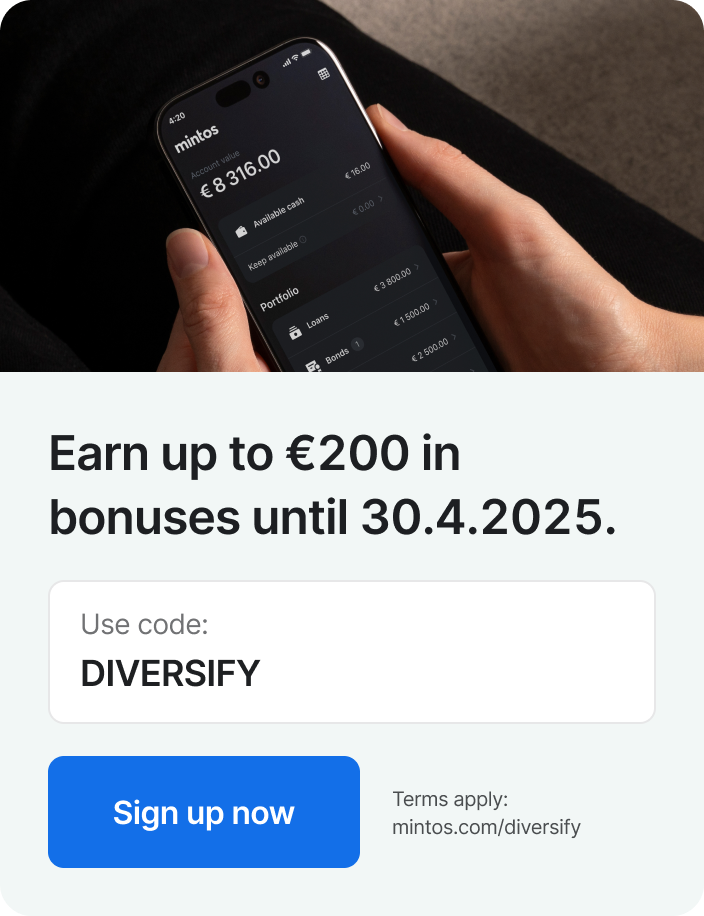Crowdfunding is an increasingly popular way of raising funds, transforming how individuals, startups, and businesses finance their projects and ideas. It emerged as an alternative to traditional funding sources like banks and venture capitalists. The roots of crowdfunding can be traced back to the late 1990s and early 2000s, with the advent of internet platforms that allowed creators to solicit funds directly from the public.
Mintos has raised money via crowdfunding in 2020, and we might consider crowdfunding in the future. If this sounds interesting, sign up for updates to be the first to get the news.
How crowdfunding works: A step-by-step guide
1. Initiators set up a campaign: Individuals or organizations create a campaign on a crowdfunding platform, detailing their project, goals, and funding needs.
2. Campaigns specify financial targets: Each campaign sets a financial goal, with a deadline. Goals can be either fixed (only receiving funds if the target is met) or flexible (funds are received regardless of meeting the target).
3. Campaigns offer rewards: To attract backers, campaigns may provide rewards or incentives, ranging from simple acknowledgments to equity stakes in the business for certain crowdfunding types.
4. Promotion to potential backers: The initiators promote their campaign through various digital channels like social media and email to reach a broad audience.
5. Backers pledge financial support: Supporters pledge money to the campaign. If it reaches or exceeds its goal by the deadline, the project receives the funds, minus any platform fees.
6. Initiators execute the project: Once funded, the initiators work on realizing the project, keeping their backers informed and delivering any promised rewards.
7. Creators receive feedback and grow: The feedback from supporters is invaluable for project refinement and future planning, fostering growth and improvement.
Crowdfunding in business
Crowdfunding offers more than just an alternative financing route; it represents a paradigm shift in how startups and small businesses engage with their market and secure capital. Here are some benefits of crowdfunding in a business landscape:
- Market validation and feedback loop: Crowdfunding allows businesses to present their ideas to a wide audience, effectively testing the market’s response before full-scale production or launch. This immediate feedback can be invaluable in refining the product or service, ensuring it meets the actual needs and preferences of potential customers.
- Building a community of supporters: Unlike traditional funding methods, crowdfunding creates a community of backers who are emotionally and financially invested in the business’s success. This community sometimes turns into brand ambassadors, promoting the business through word-of-mouth and social media, thereby enhancing brand recognition and loyalty.
- Enhanced visibility and marketing: Launching a crowdfunding campaign can serve as a powerful marketing tool. It provides an opportunity for businesses to tell their story, showcase their products or services, and gain media attention, all of which can be beneficial for long-term brand building.
- Risk mitigation: By raising funds through crowdfunding, businesses can mitigate financial risks. Since the capital is raised upfront, businesses can avoid overextending themselves with loans or giving up equity too early in their growth stage.
- Flexibility in funding: Crowdfunding offers different models – like rewards-based, equity-based, and debt-based – each catering to different business needs and strategies. This flexibility allows businesses to choose the model that best aligns with their goals and investor expectations.
- Access to a diverse investor base: Traditional funding often limits businesses to a specific investor demographic. Crowdfunding, by contrast, opens the doors to a diverse range of investors, from small-scale individual backers to more serious investors, expanding the business’s reach and potential funding pool.
- Regulatory considerations and challenges: While crowdfunding offers numerous benefits, businesses must navigate various regulatory landscapes, especially in equity and debt crowdfunding. Compliance with these regulations is crucial to maintain transparency and trust with backers.
Types of crowdfunding
Type
Description
Common Uses
Donation-based
This form of crowdfunding involves individuals donating to a cause, project, or organization without expecting anything in return.
Charitable causes, social campaigns, nonprofits.
Rewards-based
Backers receive a tangible item or service in return for their funding. Rewards vary based on the contribution level.
Creative projects, product launches, art ventures.
Debt crowdfunding
Also known as peer-to-peer (P2P) lending, where backers lend money to individuals or companies and are repaid with interest over time.
Business expansions, personal loans, refinancing.
Equity crowdfunding
Investors receive a stake in the company, usually in the form of equity shares. This means they could potentially earn dividends or see asset appreciation.
Startups, small businesses seeking growth capital.
Real estate crowdfunding
Allows individuals to invest in real estate projects. Investors may earn returns through rental income, property appreciation, or both.
Property developments, real estate portfolios, commercial real estate.
Benefits and challenges of crowdfunding
Crowdfunding offers a unique set of advantages and faces distinct challenges. Understanding these can help both project initiators and backers make informed decisions.
Benefits:
- Access to capital: Crowdfunding provides an alternative source of funding, especially useful for those who might not have access to traditional financing methods.
- Market validation: It serves as a testing ground for new ideas, helping creators gauge public interest and demand.
- Community building: Crowdfunding helps in building a community of supporters who are emotionally and financially invested in the project’s success.
- Increased visibility: Projects can gain significant exposure and marketing benefits, often leading to media coverage and heightened public awareness.
- Feedback and innovation: Continuous interaction with backers provides valuable feedback, fostering innovation and improvement of the project.
Challenges:
- Funding uncertainty: Not all campaigns reach their funding goals, leading to uncertainty and potential project discontinuation.
- Intellectual property risks: Public disclosure of an idea before securing intellectual property rights can lead to copying or theft.
- High competition: The growing popularity of crowdfunding means more projects are vying for attention, which can make standing out challenging.
- Backer management: Managing a large group of backers, especially in rewards-based crowdfunding, can be time-consuming and complex.
- Regulatory compliance: Navigating the legal and regulatory aspects of crowdfunding, especially in equity-based models, can be daunting.
Integrating crowdfunding insights into your investment strategy with Mintos
Whether you’re starting your investment journey or looking to expand your portfolio, the knowledge of crowdfunding mechanisms can enhance your perspective on risk assessment, potential growth opportunities, and portfolio diversification. Knowledge or experience in crowdfunding of course is not a prerequisite to start investing on Mintos.
Mintos offers long-term investors an easy-to-use platform for growing their money with a unique mix of traditional and alternative investments. Mintos is a licensed investment firm under MIFID, and not a crowdfunding platform. With diverse investment options including loans, ETFs, bonds, Real estate and Smart Cash Mintos enables you to find opportunities that align with your risk tolerance and financial goals, and to broaden your investment scope beyond traditional avenues.
Disclaimer:
This is a marketing communication and in no way should be viewed as investment research, advice, or recommendation to invest. The value of your investment can go up as well as down. Past performance of financial instruments does not guarantee future returns. Investing in financial instruments involves risk; before investing, consider your knowledge, experience, financial situation, and investment objectives.

